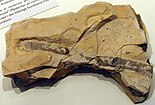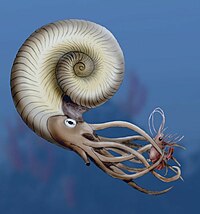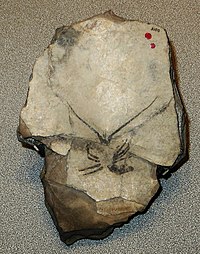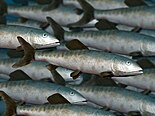| Calcare di Sogno | |
|---|---|
| Stratigraphic range: Lower Toarcian-Late Bajocian ~182–169 Ma PreꞒ Ꞓ O S D C P T J K Pg N | |
| Type | Geological formation |
| Sub-units | Livello a Pesci |
| Underlies | Formazione delle Radiolariti |
| Overlies | Calcare di Domaro, Calcare di Morbio, Unnamed limestones |
| Thickness | Typically 120–140 m (390–460 ft) East and west 70–100 m (230–330 ft) |
| Lithology | |
| Primary | Marl, marly limestone & abundance of clay Secondary: Alternation of marly limestones and marls, presence of graded Chalcudites |
| Other | Limestones with nodules of flint & subordinate marls |
| Location | |
| Coordinates | 45°48′N 9°18′E / 45.8°N 9.3°E / 45.8; 9.3 |
| Approximate paleocoordinates | 33°24′N 18°54′E / 33.4°N 18.9°E / 33.4; 18.9 |
| Region | Lecco Province |
| Country | |
| Type section | |
| Named for | Sogno |
| Named by | Gaetani & Poliani |
  | |
The Calcare di Sogno ("Sogno Limestone"; also known as the Sogno Formation) is a geological formation in Italy, dated to roughly between 182-169 million years ago and covering the Lower Toarcian-Late Bajocian stagess of the Jurassic Period in the Mesozoic Era. Thallatosuchian remains are known from the formation, as well fishes and other taxa.
Description
During the Early Jurassic, concretely towards the Toarcian, the Lombardy Basin became a relatively deep, fully pelagic area, located between the so called Lugano High, at the west, and the Trento Plateau to the east, with several troughs and palaeohighs (West to east: Monte Nudo Trough, Lugano High, Generoso Trough, Corni di Canzo High, Albenza Plateau, Monte Cavallo High, Sebino Trough and Botticino High). The formation is characterized by a disposition of regional deposition equivalent to the German Posidonia Shale, with a benthonic setting and deposition trends, mostly populated by marine fauna. The environment of the formation was related to a marginal marine deposit, with probably epicontinetal deposition from near land environments, being connected to the central European seas and the North African currents of the Toarcian. The formation is linked with the Toarcian Anoxic Event, that is measured in the “Fish Level”, that is also the most fossiliferous section.
Environment
Two cores, the Colle di Sogno and Gajum are among the best sections that recovered the ecological changes in the Pliensbachian-Toarcian Lombardy Basin. Carbon-and oxygen-isotope data calibrated against nannofossil biostratigraphy has shown that the palaeobathymetry of the deposits was about 1000 and 1500 m, being the deepest records of the T-OAE in the western Tethyan region. As the Sogno Formation was deposited mostly on a Pelagic setting, influenced by both the European and African bioregions, taxa of several provenance mix on this layers. The Nannofosil assemblage, that ranges from moderate/poor to good decreasing in the Toarcian AOE (drastic decrease in total abundance is observed in the Fish Level), includes the taxa Lotharingius (L. hauffii, L. sigillatus, L. crucicentralis, L. velatus), Discorhabdus ignotus, Diductius constans, Carinolithus (C. poulnabronei, C. superbus), Mitrolithus jansae and Watznaueria sp.1 in the Gajum Core, while the Sogno Core shows abundance of the genera Biscutum, Calyculus, Carinolithus and Crepidolithus, whereas Bussonius, Diductius, Similiscutum, Parhabdolithus and Tubirhabdus are extremely rare. The overall structure of this microtaxa assemblage trends to suggest a correlation with the biohorizon seen in coeval layers in the Lusitanian Basin, where is observed a common trend in the Western Tethys of north-south migration pathway for several organisms, including calcareous nannoplankton and ammonites.
A local index genus for environment evolution is Schizosphaerella spp. (specially S. punctulata), showing a lower valve size than in coeval layers on connected basins (Lusitanian and Paris Basins), as local result of the Lower Toarcian Jenkyns Event, indicating changues in ocean acidification and fertility rather than temperature.
Fossil content
Ichnofossils
| Genus | Species | Location | Material | Type | Origin | Notes | Images |
|---|---|---|---|---|---|---|---|
|
|
Cylindrical burrows |
Pascichnia |
|
Burrow-like ichnofossils referred to vermiform deposit-feeders. Sometimes considered a junior synonym of Palaeophycus. |
 |
Molluscs
| Genus | Species | Stratigraphic position | Material | Notes | Images |
|---|---|---|---|---|---|
|
|
Shells |
A posidoniid ostreoidan. The habitat and mode of life of Bositra has been debated for more than a century. There have been different interpretations, such as a pseudoplanktonic organism, a benthic organism related to open marine floor, where it was the main inhabitant of the basinal settings, and a hybrid mode, where it has a life cycle with holopelagic reproduction controlled by the change on Oxygen levels, and even a chemosymbiotic lifestile, related to the large crinoid rafts, being the main "Safe conduct" to evade anoxic events. All the opinions along the years led to a large study in 1998, where the size/frequency distribution, the density of growth thanks to the lines related to the shell size and the position of the redox boundary by total organic carbon diagrams has revealed that Bositra probably had a benthic mode of life. |
 | |
|
C. gemma |
|
Shells |
A Dactylioceratidae ammonite. Present and abundant on the Mediterranean Toarcian realm. |
||
|
C. lythensis |
|
Shells |
An indeterminate ammonite. Some of the specimens found are very fragmentary, making its identification complex. |
||
|
D. polymorphus |
|
Shells |
Type member Dactylioceratinae family of Ammonites. A common mediterranean genera, found on deposits along all europe. |
||
|
H. sp. |
|
Shells |
Type reprensentative genus of the Harpoceratinae ammonite family |
||
|
H. sp. |
|
Shells | |||
|
|
Shells |
Arthropods
| Genus | Species | Stratigraphic position | Material | Notes | Images |
|---|---|---|---|---|---|
|
?A. sp. |
|
1 complete specimen, MSNM i10852 |
|||
|
A. cfr. A. levis |
|
Various specimens |
A Palinuroidean Decapodan. |
||
|
C. cf.banzensis |
|
15 specimens, complete and incomplete |
An Erymidae Decapodan. |
||
|
?E. sp. |
|
Single Isolated chelae, MSNM i10855 |
|||
|
G. garassinoi |
|
Various specimens |
A Coleiidae Decapodan. Was confussed with Proeryon hartmanni specimens. |
||
|
P. hartmanni |
|
Various specimens |
An Erymidae Decapodan Crustacean, common on the mediterranean rocks. |
||
| U. cf.posidoniae
U. alpina |
|
Isolated chelae, MSNM i10851, il0863, i10864 |
An Astacidean Decapodan of the family Uncinidae. A large decapodan, with sizes up to 40 cm. |
Fish
| Genus | Species | Stratigraphic position | Material | Notes | Images |
|---|---|---|---|---|---|
|
Monte Cornizzolo |
+100 specimens |
Type member of the family Leptolepidae inside Leptolepiformes. It is the most abundant fish found on the formation. |
||
|
Monte Cornizzolo |
Several Especimens |
The main member of the family Pachycormidae inside Pachycormiformes. Large sized fish, able to reach near 1.4 m long. |
||
|
Monte Cornizzolo |
Several Especimens |
Type member of the family Pholidophoridae inside Pachycormiformes. A small sized fish, mostly related to marine deposits, associated with various predatory behaviours, including coeloids and Crocodrylomorphs. |
Crocodyliformes
| Genus | Species | Location | Material | Notes | Images |
|---|---|---|---|---|---|
|
cf.Pelagosaurus |
cf. P. sp. |
|
Various specimens MSNM V4012, MSNM V4013. |
A Thalattosuchian marine crocodrylomorph of the family Teleosauridae.The specimens found where of small size, with several characters such as opened neurocentral vertebral sutures and non sutured caudal pleurapophyses, that led to expeculate a possible juvenile or subadult status. |
Flora
Several plant leaves and fragments of wood were not identified.
| Genus | Species | Stratigraphic position | Material | Notes | Images |
|---|---|---|---|---|---|
|
|
Leaves |
Affinities with the Ginkgoaceae. Arboreal plants related to the modern Ginkgo species. |
||
|
|
Leaves |
Affinities with the Cheirolepidiaceae and Araucariaceae. Arbustive to arboreal plants with several leaf morphotypes, probably from nearshore environments. |
See also
- List of fossiliferous stratigraphic units in Italy
- Toarcian turnover
- Toarcian formations
- Marne di Monte Serrone, Italy
- Podpeč Limestone, Slovenia
- El Pedregal Formation, Spain
- Mizur Formation, North Caucasus
- Sachrang Formation, Austria
- Posidonia Shale, Lagerstätte in Germany
- Irlbach Sandstone, Germany
- Ciechocinek Formation, Germany and Poland
- Krempachy Marl Formation, Poland and Slovakia
- Djupadal Formation, Central Skane
- Lava Formation, Lithuania
- Azilal Group, North Africa
- Whitby Mudstone, England
- Fernie Formation, Alberta and British Columbia
- Whiteaves Formation, British Columbia
- Navajo Sandstone, Utah
- Los Molles Formation, Argentina
- Mawson Formation, Antarctica
- Kandreho Formation, Madagascar
- Kota Formation, India
- Cattamarra Coal Measures, Australia
Notes and references
Notes
- Bioturbed hazel-gray limestones in planar layers of about 20 cm, with concentration of gray flint and gray & reddish marls, along with calcareous marl.
References
- ^ SGN (2000). "Carta Geologica d'Italia 1:50.000 – Catalogo delle Formazioni (Fascicolo I)". Quaderni, Serie III, del SGI. 7 (1): 22–31. Retrieved 10 May 2022.
- ^ Delfino, M.; Dal Sasso, C. (2006). "Marine reptiles (Thalattosuchia) from the Early Jurassic of Lombardy (northern Italy)". Geobios. 39 (2): 346–354. Bibcode:2006Geobi..39..346D. doi:10.1016/j.geobios.2005.01.001. hdl:2318/79280. S2CID 128423512. Retrieved 10 May 2022.
- Gaetani, M. (2010). "From Permian to Cretaceous: Adria as pivotal between extensions and rotations of Tethys and Atlantic Oceans" (PDF). Journal of the Virtual Explorer. 36 (5): 13–24. doi:10.3809/jvirtex.2010.00235. Retrieved 10 May 2022.
- ^ Gaetani, Maurizio; Poliani, Giuseppe (1978). Il Toarciano ed il Giurassico medio in Albenza (Bergamo) (84 ed.). Milan: Riv. It. Pal. Strat. pp. 349–382. Retrieved 10 May 2022.
- Gaetani Escursione, M.; Erba, E. (1990). "Il Bacino Lombardo: un sistema paleo alto/fossa in un margine continentale passivo durante il Giurassico" (PDF). Congr. Naz. Soc. Geol. It. 75 (2): 1–23. Retrieved 10 May 2022.
- Channell, J. E. T.; Casellato, C. E.; Muttoni, G.; Erba, E. (2010). "Magnetostratigraphy, nannofossil stratigraphy and apparent polar wander for Adria-Africa in the Jurassic–Cretaceous boundary interval". Palaeogeography, Palaeoclimatology, Palaeoecology. 293 (1): 51–75. Bibcode:2010PPP...293...51C. doi:10.1016/j.palaeo.2010.04.030. Retrieved 10 May 2022.
- ^ Erba, E.; Gambacorta, G.; Visentin, S.; Cavalheiro, L.; Reolon, D.; Faucher, G.; Pegoraro, M. (2019). "Coring the sedimentary expression of the early Toarcian Oceanic Anoxic Event: new stratigraphic records from the Tethys Ocean". Scientific Drilling. 26 (4): 17–27. Bibcode:2019SciDr..26...17E. doi:10.5194/sd-26-17-2019. hdl:2434/698406. S2CID 210961368. Retrieved 10 May 2022.
- Erba, E.; Cavalheiro, L.; Dickson, A. J.; Faucher, G.; Gambacorta, G.; Jenkyns, H. C.; Wagner, T. (2022). "Carbon-and oxygen-isotope signature of the Toarcian Oceanic Anoxic Event: insights from two Tethyan pelagic sequences (Gajum and Sogno Cores-Lombardy Basin, northern Italy)". Newsletters on Stratigraphy. 321 (2): 451–477. doi:10.1127/nos/2022/0690. hdl:2434/923620. S2CID 246990063. Retrieved 10 May 2022.
- ^ Visentin, S.; Erba, E. (2021). "High-resolution calcareous nannofossil biostratigraphy across the Toarcian Oceanic Anoxic Event in Northern Italy: clues from the Sogno and Gajum Cores (Lombardy Basin, Southern Alps)". Rivista Italiana di Paleontologia e Stratigrafia (Research in Paleontology and Stratigraphy). 127 (3): 539–556. Retrieved 10 May 2022.
- Faucher, G.; Visentin, S.; Gambacorta, G.; Erba, E. (2022). "Schizosphaerella size and abundance variations across the Toarcian Oceanic Anoxic Event in the Sogno Core (Lombardy Basin, Southern Alps)". Palaeogeography, Palaeoclimatology, Palaeoecology. 595 (3): 110969. Bibcode:2022PPP...59510969F. doi:10.1016/j.palaeo.2022.110969. hdl:2434/969201. S2CID 247983702. Retrieved 10 May 2022.
- Keighley, D. G.; Pickerill, R. K (1995). "The ichnotaxa Palaeophycus and Planolites_ historical perspectives and recommendations". Ichnos. 3 (4). doi:10.1080/10420949509386400.
- Hauff, B. (1921). "Untersuchung der Fossilfundstätten von Holzmaden im Posidonienschiefer des Oberen Lias Württembergs". Palaeontographica. 64 (1): 1–42. Retrieved 3 March 2022.
- Röhl, H. J. (1998). "Hochauflösende palökologische und sedimentologische Untersuchungen im Posidonienschiefer (Lias e)[epsilon)] von SW-Deutschland". Tübinger Geowissenschaftliche Arbeiten, Reihe A. 48 (1): 1–189. Retrieved 3 March 2022.
- ^ Garassino, A. (2001). "I crostacei decapodi del Toarciano (Giurassico inferiore) di Sogno (Bergamo, N Italia)". Atti della Società italiana di scienze naturali e del museo civico di storia naturale di Milano. 141 (3): 187–197. Retrieved 10 May 2022.
- ^ Audo, D.; Williams, M.; Charbonnier, S.; Schweigert, G. (2017). "Gabaleryon, a new genus of widespread early Toarcian polychelidan lobsters". Journal of Systematic Palaeontology. 15 (3): 205–222. Bibcode:2017JSPal..15..205A. doi:10.1080/14772019.2016.1167786. S2CID 87613086. Retrieved 10 May 2022.
- ^ Garassino, A.; Gironi, B. (2005). "Proeryon hartmanni (v. Meyer, 1835)(Crustacea, Decapoda, Eryonoidea) and Archaeopalinurus cfr. A. levis Pinna, 1974 (Crustacea, Decapoda, Palinuroidea) from the Lower Jurassic (Toarcian) of Cesana Brianza-Suello (Lecco, N Italy)". Atti della Società italiana di Scienze naturali e del Museo civico di Storia naturale in Milano. 146 (1): 53–68. Retrieved 10 May 2022.
- Schweigert, G. (2003). "The lobster genus Uncina Quenstedt, 1851 (Crustacea: Decapoda: Astacidea: Uncinidae) form the Lower Jurassic". Stuttgarter Beiträge zur Naturkunde. 332 (4): 1–43.
- ^ Tintori, A. (1977). "Toarcian fishes from the Lombardian basin". Bolletino della Società Paleontologica Italiana. 16 (4): 143–152. Retrieved 10 May 2022.














